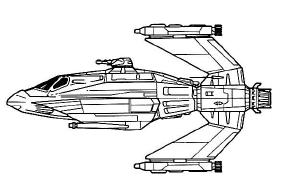The GAT-12 Skipray Blastboat from Sienar Fleet Systems was the smallest combat starship capable of hyperspace travel utilized by the Imperial Navy in the early years of the Galactic Civil War.

Despite being compact enough for deployment from capital ships as a starfighter, its substantial power generation (courtesy of a ViX multi-flux reactor by Sarylcorp), powerful armaments, and robust shielding sometimes resulted in its classification as a capital ship.
The GAT-12h, the most prevalent model in the GAT series, typically operated with a crew of four: a pilot, a copilot responsible for sensor operations, and two gunners. However, it could be flown solo. Standard equipment included a Class Two hyperdrive and a basic navigation computer with a capacity of four jump coordinates. It also carried enough consumables for one month of autonomous operation. Two Siep-Irol "Omni-Vu" sensor pylons were mounted on short wings on the sides of the cockpit.
Two forward-swept stabilizer fins extended from a rotating assembly at the rear of the ship, each containing a Dar-2 ion cannon from Mendarn Arms. During flight, these stabilizers remained vertical, positioning the ion cannons above and below the main body. For landing, the fins rotated horizontally, placing them on either side in a more conventional wing arrangement.
A third Dar-2 ion cannon was located in the ship's nose, flanked by a concussion missile launcher on the starboard side and a proton torpedo tube on the port side. A turret on the dorsal fuselage housed a linked pair of 5000x2 "Tru-Lok" laser cannons manufactured by Senko Systems.
Although designed for space, the Skipray excelled in atmospheric flight, achieving a top speed of 1,200 km/h (as reported). Its aerodynamic design allowed for superior atmospheric maneuverability compared to most airspeeders, excluding high-performance models. However, its space-based maneuverability was less impressive, often necessitating quick strikes or coordinated attacks with other vessels.

Besides the GAT-12h, other variants were produced, including the GAT-12i, the GAT-12g (which substituted the concussion missile tube with a tractor beam), the GAT-12j (featuring a larger payload and a more balanced distribution of gunnery responsibilities), the GAT-12m (offering enhanced realspace and hyperspace capabilities, making it suitable as an interceptor and courier), and the GAT-12p (equipped with an improved sensor array).
A more recent model, the Skipray 24r Blastboat, served with the Jedi Coalition during the Second Galactic Civil War.
Republic Sienar Systems conceived the design for this vessel before the Clone Wars, drawing inspiration from the earlier Turbostorm-class gunship. Many of its systems underwent testing on Toscan starfighters from Shobquix Yards, which Sienar modified into testbed gunships.

The ship was subsequently sold primarily to the Empire. The first GAT-12h Skipray Blastboats were introduced before the Battle of Yavin, becoming the smallest combat starship with hyperspace capability in the Imperial Navy's arsenal (excluding a few prototypes). The GAT-12h and its direct successor, the GAT-12i, surpassed previous models in power and combat effectiveness.
However, the Navy's tactical doctrines didn't favor a capital-starfighter hybrid with hyperspace capabilities, resulting in the ship being largely ignored. Consequently, SFS began selling the ship on the open market. Its reliable design led to widespread use in Outer Rim planetary patrol forces and smuggling operations for many years.
GAT-12 blastboats were also employed by Imperial Customs, Imperial Sector Rangers, and local defense forces. Specialized sub-models like the GAT-12m and GAT-12p saw service within the Empire.
While Imperial fleets that utilized Skiprays spoke highly of them, the Skipray Blastboat ultimately gained prominence as a mainstay in the fleets of corporations, mercenaries, pirates, and smugglers, as well as for private use by individuals such as Kir Kanos, a former member of the Emperor's Royal Guard (who flew a modified GAT-12).
Despite its initial design and marketing towards the Empire, many of these vessels ended up in the hands of the Zann Consortium, who equipped them with sensor jamming technology to enhance their survivability in space combat. During its time with the Consortium, its slow speed, combined with its heavy armor, made it an excellent fighter-bomber, filling a role similar to the Imperial TIE Defender and Rebel B-wing starfighters.
The GAT-12g variant was in service with the Imperial Navy sometime after the Battle of Yavin.
Production of the GAT-12j upgrade commenced several months before the Battle of Endor and was released a few weeks after the Imperial defeat. By 9 ABY, the GAT-12j Skipray had become the most commonly used model.
Talon Karrde utilized Skiprays for planetary defense. He lost two vessels on Myrkr during an incident in 9 ABY involving Mara Jade and Luke Skywalker.